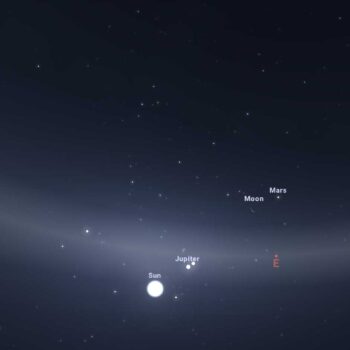June 2024 Sky
- Posted by OCastronomy
- On June 13, 2024
- 0 Comments
- Antares, Beehive cluster M44, Castor, June solstice, Jupiter, Mars, Mercury, Pleiades, Pollux, Regulus, Saturn, Spica, Venus
June 2024 Sky
| 2 | Moon at perigee (closest to Earth) at 7:25 UT (distance 368,102km; angular size 32.5′). |
| 2 | Moon near Mars at 22h UT (morning sky). Mag. 1.0. • Mars (Wikipedia) |
| 4 | Mercury 0.12° SE of Jupiter at 11h UT (12° from Sun, morning sky). Mags. −2.0 and −1.1. |
| 4 | Venus at superior conjunction with the Sun at 15h UT (not visible). The brightest planet passes into the evening sky. |
| 5 | Moon near the Pleiades at 10h UT (morning sky). • The Pleiades (Wikipedia) |
| 6 | New Moon at 12:39 UT. Start of lunation 1255. |
| 9 | Moon near Castor at 3h UT (evening sky). |
| 9 | Moon near Pollux at 8h UT (evening sky). |
| 10 | Moon near Beehive cluster M44 at 11h UT (evening sky). • Beehive Cluster (Wikipedia) • M44: The Beehive Cluster (APOD) |
| 12 | Moon near Regulus at 7h UT (evening sky). • Regulus (Wikipedia) |
| 14 | First Quarter Moon at 5:19 UT. |
| 14 | Moon at apogee (farthest from Earth) at 14h UT (distance 404,077km; angular size 29.6′). |
| 14 | Mercury at superior conjunction with the Sun at 16h UT (not visible). The innermost planet passes into the evening sky. • Mercury (Wikipedia) |
| 16 | Moon near Spica at 20h UT (evening sky). Occultation visible from western Asia. • Spica (Wikipedia) • Disappearance and Reappearance Times (IOTA) |
| 20 | Moon near Antares at 12h UT (evening sky). Occultation visible from the western Pacific ocean. • Antares (Wikipedia) • Occultation of Antares (In-The-Sky) |
| 20 | June solstice at 20:51 UT. The time when the Sun reaches the point farthest north of the celestial equator marking the start of summer in the Northern Hemisphere and winter in the Southern Hemisphere. • June Solstice (Wikipedia) • Equinoxes and Solstices from Space (NASA) |
| 22 | Full Moon at 1:09 UT. |
| 27 | Moon at perigee (closest to Earth) at 11:33 UT (distance 369,286km; angular size 32.4′). |
| 27 | Moon near Saturn at 16h UT (morning sky). Mag. 1.1. Occultation visible from eastern Australia, New Zealand and western Pacific ocean. • Saturn (Wikipedia) • Disappearance and Reappearance Times (IOTA) • Occultation of Saturn (In-The-Sky) |
| 28 | Last Quarter Moon at 21:54 UT. |
June 2024 Sky All times Universal Time (UT).
|
|


